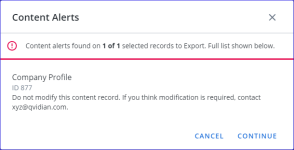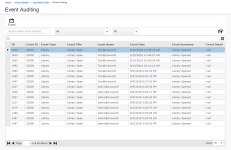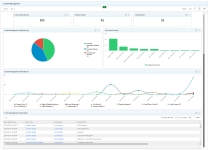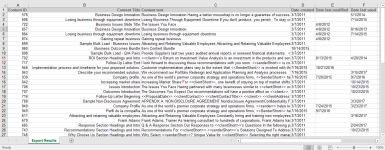Content management
Proper content management can save you time and money. It ensures your company presents the best possible RFP and proposal responses. There are many ways to manage content. Smaller organizations have a single content manager to conduct annual reviews. Larger organizations have a team of content managers to oversee the review process. The right way to manage your content depends on your company's unique makeup and processes.
Upland Qvidian has a variety of features to help you with content management. As you read about the features we offer, think about the following:
- The amount of time you can spend managing your content
- The size of your company and content management team
- The amount of content you manage
- The percentage of SMEs with a license to use Qvidian
- If your business is steady or if you get RFPs more often during a particular season
Upland Qvidian content management features fall under six main categories:
- Folders: Setting up library folders and organizing content records into folders, so they can be easily found and searched.
- Content record properties: Setting up and maintaining content records properties so they can be easily found and managed.
- Searching: Using and configuring search tools to easily locate content based on content properties.
- Communication: Communicating changes via feedback and receiving notification of updates and feedback on changes that fall outside the set review process.
- Review process: Creating and managing the review and editing process.
- Reporting: Creating, running, and viewing reports to track the content usage, edits, and identify outdated content records.
Folders
You store the content records in the library folders. A good folder structure determines the organization of the library content. Before you create or edit your folders, plan the folder structure. Think about the types of content and the quantity of each type. Look at how you want to group the content based on the content usage. Consider getting inputs from your Subject Matter Experts (SMEs) and end users.
It is always best to organize a convenient folder structure for Qvidian users. The folder structure should make sense to everyone who uses the library. A good folder structure should help users find the required content easily with minimal use of standard filters. Content managers can use advanced search techniques to find content records for content management tasks. Folder structures can be deeply nested, but we recommend that folders be no more than three levels deep.
Note: For more information on folders, see Library folders.
Tip: It is best practice to avoid storing fewer than two or more than a hundred records in a folder. Move them to the parent folder or split them into sub-folders.
Content record properties
Content managers can set up content properties to manage content records. Some of the management tasks could be:
- Using Expiry dates to flag content records that need regular updates
- Use custom metadata fields to tag SMEs who can review the content.
- Use Alerts to inform users about outdated content
- Add keywords preferred by users to find the records
Use the following properties to manage content records:
A content record title should be short and hold interest. It can be in the form of a question, but not always. It should be easy to skim and inform the user about the content in the record. You can search the Title but not the only search tool. The content text, properties, and folder help to search and filter content.
You can set an expiration date to review the validity of a content record. You can add expiration dates for all content records. Consider the following scenarios:
- A content record contains company statistics with annual updates by the HR department, then set the expiration date close to the annual update.
- A content record contains the latest product information, and the product has periodic releases, then set the expiration date to just before the next release.
- A content record contains information that will not change, for example, information on your company's founding. Set the expiration date to "Never" so it never expires.
- Some records do not have a natural expiration date. Based on your business set a safe expiration date.
- Ensure that all the records in the library do not expire at the same time. You can update content regularly and avoid major peaks that require extra resources. If you can control the expiration dates, it is best to stagger the expiration dates of the records.
- It is best practice to complete all content reviews before the expiration date. Ensure you do not send the content for review on the expiration date. The content review should be complete before the expiration date.
Note: Expiration dates do not update automatically. The next expiration date should be set manually.
The default owner of a content record is a licensed Upland Qvidian user who uploaded the file. Content owners and users with permissions can assign other licensed users as owners of a content record. Record owners ensure content is up to date with periodic reviews by licensed and unlicensed SMEs. Updates to a content record trigger an email notification to the record owners. Consider the following when assigning owners:
- Do you have multiple licensed users managing content?
- Are you considering assigning an SME as an owner? Do you feel confident about having your SMEs as the final approver of the content? If not, you can assign a different owner who can create a review workflow that includes the SME and more users.
You can store the contact information of the SME who reviews future content updates. Depending on your organization's structure, you may want to add the following:
- An individual SMEs name, phone, and email
- The role of the person(s) who reviews the content
- Department name of the group to review the content
The Comments and Alert fields should provide usage guidance and general notes. Use alerts to convey important information, and comments for content manager notes. The difference between a comment and alert is that a comment is passive and an alert is active. An alert pops up any time users make use of content. For example, when adding content as an RFP answer in a project, users must acknowledge an alert to continue to use the content record. Some common examples of Alerts include:
- A requirement to check with Compliance before using an RFP answer
- A warning that an item may be out-of-date
- Advice that an item may not apply in some situations
- Reminder to include an appendix referenced in the answer
- Reminder to include additional line items in the pricing
You can create custom metadata fields unique to your organization to help you locate, manage and report on content. Custom metadata fields can contain checkboxes, dates, drop-downs, numbers, or text. Custom metadata applies to all records in your library.
Note: If you wish to record metadata for only some but not all content, consider storing that information in Comments.
Examples of custom metadata include Compliance, Legal, or SME review date. Consider the following custom metadata fields instead of Expiration Dates:
- Review frequency - Since expiration dates do not update automaticall, you can create this custom metadata and run reports against the field to show, for example, all content that require a quarterly review.
- Contact - You can create a drop-down custom metadata field that would limit the SMEs they could choose and keep the information consistent for reporting purposes.
- Date of last material change - Upland Qvidian tracks all modifications, regardless of the extent of the edit. You can create this custom metadata field to track significant changes.
You can use links to cross-reference related records. You can view all cross-referenced records in the Linked Content Details panel. For more information, see Linked Content .
There are three types of links:
- See Also: Use the "See Also" links to reference related information, similar information, or general reference information. For example, cross-reference the following records to provide more options to users:
- Your organization has a long and short version of company history.
- Your organization has different versions of client references for different situations.
- Translation: Use "Translation" links to cross-reference duplicate records in different languages. To view all Translation linked records in the library, run the "All Content Requiring Translation" saved search.
- Content Management: Use the "Content Management" link to cross-reference records that must update together. When you update one of the records, an email notifies the owners of the linked records about the update.
Example: Consider three Content Management linked content records maintained for three business regions. The content administrators of the three business regions are also the record owners maintaining these records. When one of the records is modified the owners of the other two records are notified to update their records. This ensures the records are consistent and up-to-date.
Note: For more information on content record properties, see Content Record Properties
Searching
Content managers can use the search filters in the library to find non-text information stored in content properties. For example, you can filter based on the assigned owner(s), expiration date, times used, submitted, and custom metadata. You may need to run the same or similar searches weekly, monthly, or quarterly to get to the content that needs review. You can use saved searches without recreating them every time.
Standard public saved searches are available in the library and as quick links on the Upland Qvidian Home page. They include (my) Expired, (my) Expiring, and Submitted Content. You can also create a new saved search based on any search parameters and reuse it when needed. For example, you may need to locate expired content where the contact field includes the SME name and the content was used more than a specific number of times.
Communication
Content managers can use, or encourage the use of, feedback and email notifications to enhance communication between library users, content owners, and content managers.
Users who do not have permission to create, manage, or edit content can submit feedback to recommend changes. By using feedback, they can avoid contacting SMEs or content managers directly, which may hinder their productivity.
Users can send content feedback to notify owners that a record needs an update. For example, if there a typo in the content or a product name has changed. Users can also send general feedback unrelated to a specific record, request a new record, or recommend a change in the library.
Several events occur within Qvidian that trigger email notifications. These event notifications assist Content maintenance, Project Management, and even introduce new users to the system. Many aspects of these emails are completely customizable to fit your environment.
For example:
- You can email a content record owner when the record expires to let them know it is time for a review.
- You can set up an email trigger to automatically notify an owner when a linked content record is updated, which may require them to update their content. If you, or your Qvidian administrator, sets the trigger as customizable, you can concatenate all emails before sending them.
Review and update
Content managers and content record owners often need to coordinate with SMEs to keep the library up-to-date. There are two ways to send content for review, "Send to SME" and "Content Review Jobs." Send to SME allows the content manager to send individual files as one single file. Content review jobs can have multiple tasks, SMEs, and include visual tracking tools. Content managers and other users can edit content records directly and compare previous versions.
Consider the following as you develop your personalized content review process:
- Are your SMEs licensed Upland Qvidian users?
- Does your review require more than one SME?
- Ask your SMEs:
- How would you like to receive the files? As a single record or multiple in one file?
- Are there days or times of the year when you don’t have time for review?
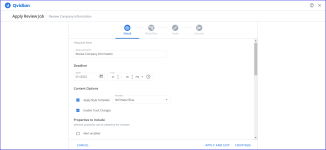
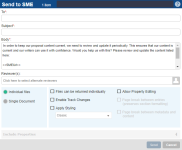
Example of the Content Assignment dialog box (left) and the Send to SME dialog box (right).
Content managers can manage content reviews using "Content Review Jobs." It is similar in function to "Send to SME" but is more robust and only available to licensed Qvidian users. Content managers can track the progress of reviews, add multiple tasks and users, monitor progress, and create activity reports.
Once a review job is complete and the updated record is in the library, activity reports are available from the Review Job History tab in the record's properties. Compliance and auditing teams can use this report to confirm correct review procedures were followed.
You can send content records to Subject Matter Experts (SMEs) to review and edit using the Send to SME job option. Send the records as individual files or a single composite document containing all the records. Send to SME jobs trigger emails with a URL link to the records. The SME clicks the link to display the records in the SME Edit page. After the SME edits and returns them to the Jobs page, you and other reviewers can approve or reject the updated record on the Jobs page
Project owners can submit new content added to a questionnaire to a content manager to review and enable in the library. On submission, a content ID is assigned to the record and added to the library as an orphaned record. It is disabled and is not accessible by other users. The content manager selects a folder, approves it, and enables it in the library for use by other users. Before approving a content record, the content manager can edit it, assign it to an SME, or reassign it to another content manager. The content manager can also reject and delete the content from the library.
Upland Qvidian allows you to edit one or more content records at a time and in different ways. Microsoft Word or PowerPoint files allow editing of the record content along with the record's properties and style templates.
Note: For more information, see About editing content records.
The "Revisions Details" panel of a content record lists the content revision history, including the user who revised it and the date of revision. You can open the previous version to view and compare the content in Word or PowerPoint.
Note: For more information, see Content Record Details Panel.
Reports
Library, Event Audit, and Duplicate Content reports can display in a grid or export to an Excel spreadsheet. Upland Analytics reports display and export to a variety of formats. Event audit reports have more events, but Upland Analytics is more visual. Library reports do not rely on event audits and include different kinds of information, such as titles and properties. You will most likely use a combination of these reports to manage your content.
The "Duplicate Content" report lists duplicate content records and include the content text and record properties. Use this report to purge unnecessary records. This report is available from the grid on the Reports page. If not visible, add a new report and choose Duplicate Content from the View drop-down.
You can also find duplicate content records from the Similar Content details panel in the Library. For more information, see Similar Content .
You can enable one or more auditing events to track changes to content properties over time. You can monitor Audit events on the Event Auditing View page. When an event occurs, you can view its details on the grid. Unlike library reports that just show the latest usage details, Event Audits show the usage details of a content record, including the Upland Qvidian users who made the changes.
Upland Analytics is a dynamic tool that uses current data to create reports. These reports can be in the form of bar charts, pie charts, or tables, and can be filtered. You can use Upland Analytics to view statistics and trends, such as content and document types usage and user activity. Standard Dashboards collection is a group of predefined dashboards created by and comes standard with the application. It includes the Users, Created Documents, Content Usage, Content Expiration, RFP Projects, and Review Jobs dashboards. For example:
- Documents used in created documents and RFPs
- Number / percent of expired or expiring records, including expiring content used in a document type
- Information about every content record that is part of an in-progress or completed content review job
Note: Analytics is only available to those with an Analytics license who have been granted access. To arrange licenses, or find out more about how it can help your organization, please contact your Upland Qvidian Account Manager.
You can create reports from the library by exporting the search results. All the information displayed on the grid will be exported into an Excel spreadsheet. This can help you identify:
- Rarely used content
- Out of date content (If you have not set expiration dates in the content record properties, you can use the last modified date to find records that may be outdated)
- Similar content based on the title
Tips for updating your library content
Over time, libraries grow and are more likely to have unused, outdated, or duplicated records. If you have unnecessary content, purging it can make it easier for you to manage and for your end users to find what they need. You can either update the library or remove all content and start from scratch.
Tip: Consider an 80/20 rule for content: 80% of RFP are starting point answers, RFP writers will customize from there. 20% of the answers are so unique that it is not worth storing them in the library. You can run a library report to find content rarely used..
To update your existing library, you must eliminate outdated, unused, or content and then review the most frequently used. You must update your Word template to the latest and apply the updated template to existing content if necessary.
If you choose to start from scratch, consider what content and how much of it you want to have in your library to start. Identify and load commonly used content by taking your most recent representative RFP, scrub answers for maximum usability and bulk load the RFP to get the content into the library. Then, take a second representative RFP, identify answers not already loaded from first, and bulk upload those as well. You can repeat this process as many times as you like until you feel confident that you have all the content you need. Also, you will need to update your Word style template, if it is not current, and apply the updated template to existing content if necessary.
Get help from Upland Qvidian
Upland Qvidian has additional resources, both free and fee-based, that can assist you with content management including:
- Our free Open Q&A sessions. This is a great opportunity to discuss content management with our experienced trainers.
- The Upland Qvidian Community. Ask other Upland Qvidian users about their experiences with content management.
- The Upland Qvidian University Advanced Content Management course. This 9-hour course, split over 3 days, covers all the topics above and more, with demonstrations, examples, and hands-on activities to help you identify a process that works for you.
- Consulting services and custom training. We offer a variety of online and on-site services to help you set up an efficient review workflow process, audit your content record, and train your users. Contact your Upland Qvidian Account Manager to learn more about our services.
